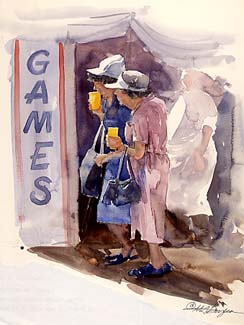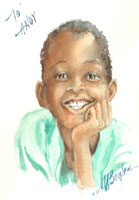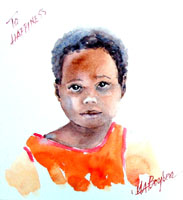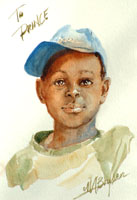Lesson 10
By Mary Ann Boysen
When little watercolor figures and faces are needed to add action to a painting, I have found this a wonderful tool in helping me use just the right shape. Of course, if the figures are more prominently placed in the foreground, more detail would be necessary.

These ladies were sipping on lemonade on a very hot day at the local County Fair. I found the backlighting to be dramatic, and their simple shapes to be intriguing.

Using techniques learned from the above illustration, AND my experience with negative painting, I was able to capture their stance and movement quickly with the brush. Since they are in the foreground, they needed more shaping and detail than the figure in the background.
Seeing that the sun was high in the sky, I kept a strong light on their caps. There was no need to define their faces more than just the profiles which were emphasized by the background...and the shoulder of the figure in the blue dress.
The man in the apron inside the tent was not an important figure so there is no detail...just a suggestion of the apron that he was wearing to prepare the food in his booth.
Quick Portrait Studies
I am really not a formal portrait artist, but found that I could do quick watercolor sketches of these adorable children in South Africa.
My favorite experience with faces are the little quick portrait studies that I painted of the children in South Africa in Sparrow Village. Given no time to think about how I would do these, I just took a deep breath, and prayed that they would sit still.....and sit still they did!
Each sat for at least a half hour, which is something I doubt an American child would do. They had never seen an artist pay attention to them. All that most do is take pictures, a camera flashing in their faces every day (and I am also guilty of that!). They were fascinated with the development of a likeness by using a brush and some paint.
Painting makes me happy, the adrenalin surges, and a smile glues itself to my face, so I was exhausted but thrilled with doing just this small thing to make them happy too. Even the nurses and aids got in on the act. Everyone wanted a portrait.

Andy

Boitumelo

Happiness

Prince
To begin the portraits, I did a brief pencil sketch, concentrating on the placement of the eyes, and being careful to get the length of the nose in proportion to the width of the eyes. It doesn't matter how you measure, but since I had drawn the eyes, I measured the distance between them (looking at the actual person) and then looked at the nose to see if it was longer or shorter than that distance. Nose length is one of the biggest mistakes that an artist make so I tried to concentrate on this relevance.
After the features are drawn, I wet the image with clear water so that I could get an even flow of color when I began painting. The light is bright in South Africa, and I was aware that there were many colors in their skin. I tried to emphasize some of the colors and reflected light. Some of their foreheads were blue with the reflection of the sky. Don't hesitate to put color into skin. There is NO correct flesh color in a tube!
Using brown madder, alizarin, yellow ochre, turquoise, cadmium red light, cobalt blue hue, sap green among other colors, I proceeded painting the faces. If the paper is wet or damp, the colors blend very easily. You don't want to mix them on the palette, as they turn to mud, but side by side on the paper, they do the work for you. For more of the portraits see the Sparrow Village page on my personal site.
My Self-Portrait (click on each to see the video process)
 1.Establishing the flesh tones 1.Establishing the flesh tones
 2. Painting the eyes and mouth 2. Painting the eyes and mouth
 3. In this video I am showing you how to add color other than fleshtones to the face. We are all affected by the colors around us, and here I have a blue shirt on which reflects blue into the lower edges of the facial structure. The chin, nose and neck have blue glowing in them and still the fleshtone is apparent. 3. In this video I am showing you how to add color other than fleshtones to the face. We are all affected by the colors around us, and here I have a blue shirt on which reflects blue into the lower edges of the facial structure. The chin, nose and neck have blue glowing in them and still the fleshtone is apparent.
 4. Here I detail the hair, eyes, nose and mouth, adding more color and depth to the painting 4. Here I detail the hair, eyes, nose and mouth, adding more color and depth to the painting

Lesson 11: Watercolor Painting Crystal >>
<< Lesson 9: Watercolor Glazing
Return to Watercolor Lessons
Related topics:
Portraits
|

